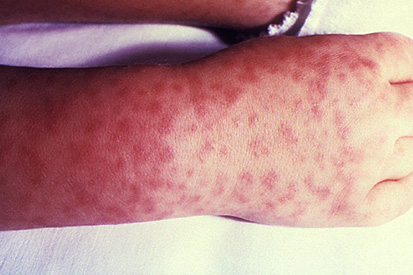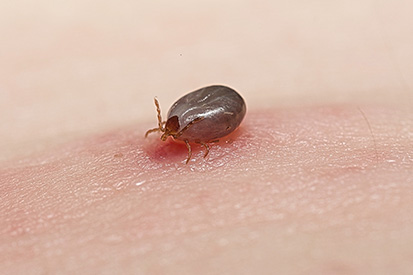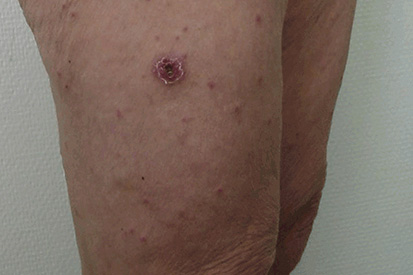Rocky Mountain Spotted Fever
At Dermatology of Southeastern Ohio, our experienced team is committed to providing comprehensive care, offering expert diagnosis and treatment options to ensure the health and safety of our patients faced with tick-borne illnesses like RMSF.
Examples of Rocky Mountain Spotted Fever



What are the Symptoms of Rocky Mountain Spotted Fever?
- Rocky Mountain Spotted Fever is characterized by a rash that begins as small red spots or blotches on the wrists, ankles, palms or soles of the feet. It spreads up the arms and legs to the trunk of the body. These symptoms take between one and two weeks to appear following a tick bite.
- The rash is often accompanied by fever, chills, muscle ache, red eyes, light sensitivity, excessive thirst, loss of appetite, diarrhea, nausea, vomiting and/or fatigue.
Causes of Rocky Mountain Spotted Fever
- Rocky Mountain Spotted Fever (RMSF) is primarily caused by the bacterium Rickettsia rickettsii. This bacterium is transmitted to humans through the bite of infected ticks, with certain species acting as vectors.
- Ticks such as the American dog tick, the Rocky Mountain wood tick, and the brown dog tick are common carriers of Rickettsia rickettsii.
- The life cycle of the bacterium involves ticks and certain mammals, such as rodents and dogs, serving as hosts.
- Humans become infected when bitten by an infected tick during any stage of its life cycle.
How to prevent Rocky Mountain Spotted Fever
Preventing Rocky Mountain Spotted Fever (RMSF) involves minimizing tick bite risks. Avoid grassy and wooded spots, choosing clear trails. Use EPA-approved tick repellents like DEET or picaridin on exposed skin and clothing and wear protective clothing, including long sleeves and pants.
Regular tick checks post-outdoor activities, focusing on hidden areas, are vital. Prompt and proper tick removal with fine-tipped tweezers is crucial. These measures significantly reduce RMSF risk, promoting well-being in tick-prone environments.
Acne FAQs
Over-the-counter acne products typically contain ingredients like benzoyl peroxide, salicylic acid, or alpha hydroxy acids. These products can be effective for mild acne. Prescription treatments, on the other hand, may include stronger formulations of these ingredients or other medications such as topical or oral antibiotics, retinoids, or hormonal therapies. Your dermatologist can assess the severity of the acne and recommend an appropriate treatment plan.
The timeline for acne improvement can vary depending on the severity of the acne, the chosen treatment, and individual factors. Over-the-counter products may show initial results in a few weeks, while prescription medications, such as topical retinoids or oral antibiotics, may take several weeks to a few months. It's important to be patient and consistent with the recommended treatment plan. If there's minimal improvement or worsening of acne, your dermatologist may adjust the treatment.
Acne is a common skin condition that can affect people of all ages, genders, and ethnicities. It is most commonly associated with adolescence due to hormonal changes during puberty, but acne can persist or develop in adults as well.
While acne can be frustrating, it is a treatable condition. Consulting with your dermatologist can help determine the most appropriate treatment plan based on individual skin type and the severity of the acne.
Dermatologists tailor acne treatments based on the individual's skin type and the severity of the condition. Common treatments include topical medications like retinoids and benzoyl peroxide, oral antibiotics, and, in some cases, oral contraceptives or isotretinoin. Light and laser therapies may also be recommended. Results vary, but many patients experience a significant reduction in acne lesions, improved skin texture, and minimized scarring. Consistency with the prescribed treatment plan is key to achieving optimal outcomes.
Dermatologists offer various treatments to address acne scarring, including laser therapy, chemical peels, microneedling, and fillers. While complete removal of scars may not always be possible, significant improvement is often achievable. Dermatologists work with patients to develop customized treatment plans, providing realistic expectations and guiding them through a process that can lead to smoother, more even-toned skin.
Early intervention and consistent follow-up with a dermatologist are crucial for optimizing outcomes in the management of acne and its potential scarring.
From our QualDerm Family of Brands: Acne Treatment Options
How to treat Rocky Mountain Spotted Fever
The primary treatment for Rocky Mountain Spotted Fever (RMSF) involves prompt administration of antibiotics,
If RMSF is suspected, seeking prompt medical attention is essential. Schedule an appointment with us today for timely and effective care.
Early diagnosis and treatment significantly improve outcomes and reduce the risk of complications associated with Rocky Mountain Spotted Fever, especially for individuals bitten by ticks in endemic areas.
Featured Products for Acne

Bright Girl Gel Facial Cleanser
Bright+Clean Gel Facial Cleanser is a pH-balanced cleanser (pH= 5.5-6.5) is designed to work with your skin’s barrier while washing away dirt, sweat, and make-up. Bright+Clean cleanses and nourishes with a subtle natural fragrance that is designed to positively reinforce consistent use. 6.7 FL OZ (200 ML)

SkinCeuticals Blemish + Age Defense
Blemish + Age Defense is a targeted, oil-free approach for aging skin prone to breakouts. This first-to-market acid blend combines 2% dioic acid with an optimal alpha- and beta-hydroxy acid formulation to reduce the formation of acne and clogged pores. 1 fl oz / 30 mL
